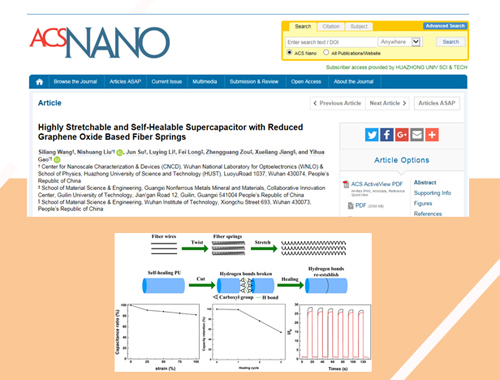On January 23rd, the latest research achievement of Prof. Gao Yihua’s team, entitled Highly Stretchable and Self-Healable Supercapacitor with Reduced Graphene Oxide Based Fiber Springs, was published online on ACS Nano, a prestigious journal of the American Chemical Society. Prof. Gao was hired both by Wuhan National Laboratory for Optoelectronics and School of Physics. The PhD candidate Wang Siliang is the first author of this paper, Prof. Gao is the corresponding author and Associate Professor Liu Nishuang is the co-corresponding author.
In large-scale applications of portable and wearable electronic devices in recent years, high-performance supercapacitors are important energy supply sources. However, since the reliability and stability of supercapacitors are generally destroyed by mechanical deformation and damage during practical applications, the stretchability and self-healability must be exploited for the supercapacitors.
To date, many stretchable supercapacitors have been fabricated by creating wavy electrode materials on polymeric substrates, coating active materials on textiles, and wrapping conductive materials on elastic polymeric fibers. These above supercapacitors with mechanical robustness are made by a similar method of depositing electrode materials onto a stretchable substrate. However, the additional substrate adds weight and volume and consequently lowers the performance of the devices and makes further integration inconvenient. Furthermore, the stretchability and complex shape change are severely limited by the confined deformation of the underlying substrate. Here, Prof. Gao’s team developed intrinsically stretchable material structures and electrodes without additional substrates though numerous experiments and trials. By wrapping fiber springs with a self-healing polymer outer shell, a stretchable and self-healable supercapacitor is successfully realized.

As is shown in the research, the supercapacitor has 82.4% capacitance retention after a large stretch (100%), and 54.2% capacitance retention after the third healing. Then the stretchable and self- healable supercapacitor was used to drive a photodetector of perovskite nanowires. After healing, the on/off ratio only had a slight decay, which demonstrated the good restoration of the supercapacitor’s function. The successful preparation of stretchable and self-healable super- capacitors may provide a way to design and fabricate multifunctional supercapacitors and other next-generation multifunctional electronics devices, even a solution to expand the lifetime of future stretchable electronics devices, meeting the requirement of sustainability.
This work was supported by the National Natural Science Foundation of China (11374110, 11674113, 51371085, 11304106, and 11204093).
Link:http://pubs.acs.org/doi/abs/10.1021/acsnano.6b08262
